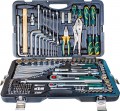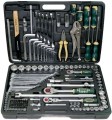Socket heads (6 points)
Number of
hex sockets included in the tool kit.
All end heads are accessories for a collapsible tool; during operation, they are mounted on a ratchet, wrench or other similar device. The head itself has the appearance of a characteristic “cap”, which, during operation, is put on a bolt, nut, etc. This design, among other things, allows you to work with parts located in recesses and some other hard-to-reach places that cannot be reached with open-ended, captive or split keys. And compared to a set of classic socket wrenches, the holder plus socket set takes up much less space, providing almost the same functionality.
As for the 6 faces, this type of socket head is the most famous and widespread, because. most modern nuts and bolts have this shape.
Socket heads sizes (6 points)
Working size range of hex sockets (see above) supplied with the kit. This parameter allows you to evaluate how the heads fit the dimensions of the fasteners with which they are planned to be used.
Socket heads (Surface)
The number
of Surface sockets supplied with the tool kit.
All end heads are accessories for a collapsible tool; during operation, they are mounted on a ratchet, wrench or other similar device. The head itself has the appearance of a characteristic “cap”, which, during operation, is put on a bolt, nut, etc. This design, among other things, allows you to work with parts located in recesses and some other hard-to-reach places that cannot be reached with open-ended, captive or split keys. And compared to a set of classic socket wrenches, the holder plus socket set takes up much less space, providing almost the same functionality.
Specifically, this type of socket is also called
SuperLock, or "heads for torn edges." They are intended for hexagonal fasteners and, in accordance with the name, have increased efficiency on heavily worn parts. The working surface of the Surface / SuperLock heads has the form of a circle with six characteristic rounded protrusions, which, when working, are adjacent to the midpoints of the faces of the fastener — due to this, the force is applied not to the corners of the hexagon, but to its sides. This not only allows you to work with stripped edges, but also reduces the risk of failure on intact fasteners; thanks to this, it becomes possible to work with great effort, without fear of damage. On the other hand, this advantage is relevant only if the size of the h
...ead strictly corresponds to the size of the part — otherwise, the risk of failure, on the contrary, increases.Socket heads sizes (Surface)
The range of working sizes of Surface sockets (see above) supplied with the kit. This parameter allows you to evaluate how the heads fit the dimensions of the fasteners with which they are planned to be used.
Open end wrenches
The number of open-
end wrenches supplied in the kit. Note that some modern kits
only include open-end wrenches, without any other fixtures or accessories.
Open-end wrenches are called classic wrenches with a U-shaped working profile. When working, they cover the part from three sides (on two — if the key clings to the very tips of the "horns"). Because of this, such wrenches lose to ring wrenches in terms of uniformity of impact and are less suitable for work in which significant efforts are required (horn tools are more likely to break off the part). However, in most cases this shortcoming is not critical. In addition, the U-shape of the profile allows you to work with pipelines, hoses, etc., on which it is impossible to put a spanner wrench, and also makes it possible to hold an open-end tool during operation similar to a screwdriver — not perpendicular to the axis of rotation of the fastener, but parallel. Due to this, in some cases, this type of key may well replace the end keys (see below).
Note that most often modern open-end wrenches are made double-sided, with working profiles of different sizes at different ends. As for the quantity, it is worth considering here: sets with the same number of keys of the same type may differ in the specific sizes of these tools. Such nuances should be clarified before buying separately.
Ring wrenches
The number of
ring wrenches supplied in the kit. Note that some modern kits include
only ring spanners, without any other fixtures or accessories.
The working profile of the ring wrench has the shape of a ring; the inner surface of this ring, in direct contact with the fastener, has the shape of a polyhedron or "asterisk"; Such a wrench covers the fastener from all sides, which provides an even distribution of the load and better suitability for working with high forces than open-end wrenches (see above). At the same time, cap tools are less versatile: if the shape of the part does not match the working profile or if this part is located in a hard-to-reach place, serious problems can arise during work. In addition, they are not applicable to work with fastening hoses, pipes and other similar items — unless such an item is fixed only on one side, and on the other, a key can be put on it.
Note that most often modern box wrenches are made double-sided, with working profiles of different sizes at different ends. As for the quantity, it is worth considering here: sets with the same number of keys of the same type may differ in the specific sizes of these tools. Such nuances should be clarified before buying separately.
Combination wrenches
Number of
combination wrenches supplied with the kit. Note that some modern kits include
only combination wrenches, without any other fixtures or accessories.
Combined are called bilateral keys, on which different types of working profiles are located on different sides. Most often, such keys combine open-end and cap profile, very rarely — open-end and end. The technical features of each of these types are described in the corresponding entries in the glossary. However, anyway, the working dimensions of the profiles in one tool, usually, are the same — this allows, without changing the key, to choose the best option for a specific part, depending on the features of the work. As for the quantity, it is worth considering here: sets with the same number of keys of the same type may differ in the specific sizes of these tools. Such nuances should be clarified before buying separately.
Split ring wrenches
Number of
split wrenches supplied in the kit. Note that some modern kits include
only split wrenches, without any other fixtures or accessories.
According to the shape of the profile, such tools are a cross between open-end and box wrenches (see above). In fact, the working part of the split key looks like a cap ring, from which a small part was cut out, turning this ring into “horns”. However, such tools also differ from open-end wrenches: the “horns” mentioned are clearly bent towards each other, and the surface in contact with the fastener does not have the shape of the letter “U”, but of a pronounced hexagon or asterisk.
Thanks to this design, split wrenches provide a much better distribution of force over the fastener than open-end wrenches, and at the same time do not have such restrictions on use as box wrenches. To illustrate, we can cite the use of such a tool in a car service. It is split wrenches that are considered the best option for servicing brake systems, fuel and oil lines, etc.: they allow you to securely tighten fasteners and at the same time work without problems in hard-to-reach places and with hose attachments where box wrenches would be useless.
Note that most often modern split wrenches are made double-sided, with working profiles of different sizes at different ends. As for the quantity, it is worth considering here: sets with the same number of key
...s of the same type may differ in the specific sizes of these tools. Such nuances should be clarified before buying separately.
